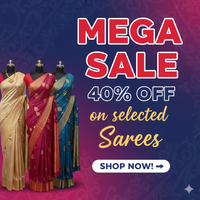Chikankari - The Knotty Knack of 'Shadow Work Embroidery'
Share
Meaning:
The meaning of 'Chikankari' is 'embroidery' and the word is derived from the Persian expression, 'Chakeen' or 'Chakin' which relates to the formation of fine 'needle work' designs on cloths.

History:
It is believed that initially 'Chikankari' was introduced in Lucknow (the present capital city of UP, India) and that was when the Mughals ruled the country; the major motivation factor behind the creation of 'Chikankari' was the Persian designs. According to a popular belief, it was Noor Jehan, the wife of Jahangir (the Mughal Emperor) who initiated 'Chikankari'. However, it must be also added that Megasthenes, the Greek explorer had mentioned about the 'Chikan' work of Indians way back in the 3rd century BC! It is generally assumed that the main inspiration for the 'Jaali work (mesh design)' of 'Chikankari' is the Turkish architectural splendor.
Chikankari technique:
The basic cloth used for 'Chikankari' creation are 'chiffon', 'muslin', 'georgette', 'silk', etc, and for embroidery work, white yarn is used. That being said, yarns of different colors are also made use of for the same these days; besides, extra decoration works are also done using 'Badla', 'Mukaish', 'Beads', 'Kamdani', 'Mirrors', and 'Sequins'.
Design printing is done as the first step, and for this, precisely created wooden blocks (moulds) are used. These are doused in the previously prepared color blend (mix of indigo, glue, and water) and using this, the desired designs are created. Subsequently the embroidery work is carried out (either using one color cord or multicolored cords). The generally made designs are 'creepers', 'paisley', 'fruits', different 'flowers', 'parrots', 'peacocks' or similar birds. The final work begins after these initial procedures, and this includes various processes such as 'rinsing', 'blanching (bleaching)', 'acid treatment', 'starching', and 'pressing (ironing)'.




Recognizing 'Chikankari'
The main distinguishing factor is the shady impression that is introduced in the base cloth. The stitching work is carried out on the rear side of the cloth so that the images appear somewhat dense, when looked through the front side. Because of the 'diagonal crisscross' stitching style, the images look slight and delicate, and this is again underscored by using slight stitches.
Commonly the right side is decorated using 'darning' or 'running' stitches. It is also seen that, in some cases, 'jali' stitch is also made use of and here, the 'weft' and 'warp' cords are precisely segregated and tiny stitches (buttonhole style) are put in.


Chikankari types:
Generally 'Chikankari' can be classified by taking into account the given patterns; there are mainly three patterns: 'Jali', 'Flat', and 'Raised' stitches.
Flat Stitches and Their Conventional Terms
The conventional 'Flat' stitches are 'Taipchi, 'Bakhia', 'Jangira', and 'Gitti'.
'Taipchi': 'Taipchi' is utilized to fill up the sketched leaves and petals of the design and 'running' stitching style is used here.

'Bakhia' stitches are effective in bringing in a shady look, and the style is more or less comparable to 'herringbone' stitching.

Jangira: Here, 'chain' stitching style is used for sketching.

Gitti: This is a mix of 'satin' and 'buttonhole' stitches, and is mainly used to create designs like wheels which have small center holes.

Raised and Imprinted Stitches and Their Conventional Terms
Murri:
Here 'satin stitches (diagonally created)' are used along with the knot and this creates the form of a grain.

Phanda:
This is another version of 'Murri', an abridged form. In this style, small round knots are created which produces a lifted appearance.

Dhum Patti:
Here, 'cross-stitches' are made use of for creating 'leaf designs'.

Ghas Patti:
In this pattern, stitches are done in 'V-shape' to form grass leaves.

Jaali (Mesh) Work:
This is done by separating out the 'wefts' and 'wraps' by using needle and this gives open mesh appearance.

Interesting Facts:
-
In the beginning, 'Mulmul' (superior quality cloth) was used for 'Chikankari' work.
-
West Bengal is another place where 'Chikankari' is popular.
-
As white cords and white cloths are widely used in the creation of 'Chikankari', the product is also termed as 'White Embroidery'.











1 comment
I really like this post https://www.ethnava.com/ online shopping portal